
Project Description
Toolkit of hands-on STEM (science, technology, engineering, and math) activities based on NASA's continuing pursuit of human exploration of the Moon and Mars and a mobile app that launches users further into the solar system. Physical and digital resources will be shared to leverage local partnerships to engage diverse audiences and support at home STEM learning beyond museum walls.
Downloadable Kit Resources
https://www.nisenet.org/solarsystem-kit
Companion Apps with Hands-on Activities
DIY Sun Science App
DIY Solar System App
Kit Report Now Available - Due December 1, 2023
All partners receiving physical kits are required to submit an online report to the NISE Network about their experiences. In turn, the NISE Network is then required to share summaries of this data with our funders. The report must be submitted online through Alchemer (Survey Gizmo) using the following link.
https://survey.alchemer.com/s3/7577264/Voyage-Solar-System-2023-Report
You can preview the report in a PDF or Word Doc version:
Please note:
- The report asks about your public engagement efforts in 2023, and then asks about plans for 2024.
- Some of the questions will also ask about other NISE Network Earth and Space content.
- The report takes about 30 minutes to complete; we recommend using the Word Doc preview above to draft your responses and then cut-and-paste these into your final online submission.
Opportunities
Physical kits will be distributed to 350 eligible institutions. Digital materials will also be freely available.
How to Apply for a Physical Kit
- Applications were due May 15, 2023; we are no longer accepting applications.
- Overview:
The overview includes application instructions, eligibility requirements, and project expectations.
Please read the overview and preview the application before applying: - Online submission:
Applications must be submitted online using Alchemer (SurveyGizmo): - Preview the application (just for reference; application must be filled out online):
Project Timeline
- 2021 - 2023: Activity development, prototyping, and testing
- 2022: DIY Sun Science App launches
- 2023: March - physical kit application opens
- 2023: May 15 - physical kit application deadline
- 2023: July - kit award notifications
- 2023: Late Summer - physical kits distributed
- 2023: Late Summer - Voyage though the Solar System Kit available online
-
2023: November 1 - partners who received a kit are required to submit an online report describing current or planned use of the resources (a report template will be provided)
- 2023: DIY Solar System App launches
- 2024: Implementation continues
Project Partners
The project is led by the Sciencenter in Ithaca, NY
Project team members and advisors include:
- Children's Creativity Museum, San Francisco, CA
- Arizona State University, Tempe, AZ
- Museum of Life and Science, Durham, NC
- Science Museum of Minnesota, Saint Paul, MN
- Lawrence Hall of Science, University of California Berkeley, CA
- SPIF, Cornell University, Ithaca, NY
- Emily Maletz Graphic Design, Portland, OR
- Swift Creek Media, Raleigh, NC
- Yellow Cow Consulting, San Francisco, CA
Partnerships include:
- NASA STEM Engagement
- NASA Human Exploration and Operations Mission Directorate
- NASA Science Mission Directorate
- NASA Museum & Informal Education Alliance
Learn more
- Voyage through the Solar System physical kit recipients:
https://www.nisenet.org/voyage-through-solar-system-kit-recipients - Voyage through the Solar System kit resources for download:
https://www.nisenet.org/solarsystem-kit
Acknowledgements
This material is based upon work supported by NASA under award number 80NSSC21M0082. Any opinions, findings, and conclusions or recommendations expressed in this material are those of the author(s) and do not necessarily reflect the view of the National Aeronautics and Space Administration (NASA).
